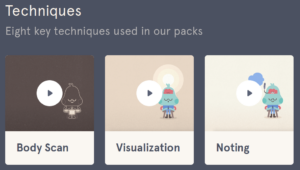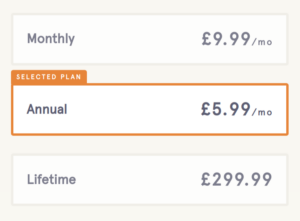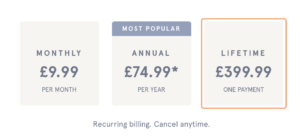If there is only one meditation app you’ve heard of, chances are it’s Headspace. With 31 million users and a million paying subscribers, it’s meditation gone mainstream.
Headspace is free to try but you have very limited access to the Headspace content library unless you pay for a subscription. At $12.99 or £9.99 per month it’s not cheap – is it worth it?
I decided to find out. I already had a meditation habit and preferred unguided meditation (sitting in silence, possibly with some bells). At the time I was travelling and finding it difficult to meditate in hostel rooms and public spaces. As I was sitting in a hostel room, having just listened to a talkative Iranian beekeeper try to explain the differences between European and Iranian beekeeping in his broken English, I took the plunge and took out a year’s subscription to Headspace. My thinking was that if I put my earphones in and shut my eyes, and had some vocal guidance to cover the background noise, then I could carve out a few minutes to meditate even in a 10 bed dorm room. It worked!
What does Headspace offer?
Headspace provides guided audio meditation, with Andy Puddicombe, a former Buddhist monk, as your guide. There are also video tutorials, with cartoon graphics helping to explain the techniques you’ll practice. The app assumes you’re a complete newcomer to meditation, and allows you to try a few sessions for free. For paying subscribers there is a whole range of guided meditations using a variety of meditation techniques.
The Headspace library is arranged into packs of between 10 to 30 sessions. Each session tackles some particular aspect of life, such as a particular emotion (Anger, Regret), quality of character (Patience, Self-Esteem, Productivity), or activity (Mindful Eating, Training, Sleep). Each meditation can be run as a 10, 15 or 20 minutes session. There are also “singles”: these sessions you can use anytime and are not part of a pack.

Each pack utilises one or two of the eight key meditation techniques which have been deemed appropriate to the pack’s theme. These are: Body Scan, Visualisation, Noting, Loving Kindness, Reflection, Skillful Compassion, Resting Awareness, and Focused Attention. This focus on techniques makes Headspace a useful guide for those beginning to meditate. The variety can also be helpful for experienced meditators who may have become accustomed to a particular technique (e.g. focusing on the breath) but might benefit from integration alternative techniques like body scans into their practice.
One teacher, or many?
One of the downsides of Headspace is that all the meditation content is provided by Andy Puddicombe and not other meditation teachers. I found that when practising daily with Headspace, I began to be irritated by his voice and style. Something about his slightly Americanised British accent really gets on my nerves. Perhaps Headspace could provide an “Irritation” pack to help me through this!
This might sound silly but there’s a serious point here: if you’re going to invite a person’s voice into your life 10-20 minutes a day it’s best that you find it pleasant to listen to. If you love Andy’s voice, perhaps Headspace is for you. I personally would rather experience guided meditations from a number of different teachers, not only for vocal reasons but to hear techniques explained in different manners. For example, I was recently listening to guided meditations by Joseph Goldstein and I found his explanations far more helpful.
Headspace on other devices
Headspace has recently expanded into voice services, making their content available on Amazon Alexa and Google Assistant. If you have a Headspace subscription you can access most of the content of the mobile app via these virtual assistants. I haven’t tried it, but if you use Alexa or Google Assistant, Headspace might be a good choice for you.
Headspace also have an app for Apple Watch but this currently has only two meditations and does not link up with your subscription.
The bill, please?
Over the year of my subscription I completed 128 sessions totalling 23 hours – almost a day of my life! Was it worth the subscription cost?

Well, I don’t regret subscribing for a year, but I have not renewed my subscription. As someone who had been meditating for a couple of years at the time, it helped me to develop my meditation practice further and introduced me to a range of techniques. But since I am now comfortable meditating without guidance, I no longer feel a Headspace subscription provides good value. The monthly cost (£9.99 in the UK and $12.99 in the US) is more than a Netflix subscription, and though I’m sure that the Headspace subscription would be healthier, you’re getting access to a far smaller library of content than Netflix so Headspace just feels overpriced. There are deals available for certain groups, including students and Spotify subscribers – these can make it far more affordable.
I can see why it costs so much. Headspace Inc. has over 100 employees, and they are constantly developing the app. During my subscription period, they overhauled the whole look and feel of the app in one update. So they are clearly investing in the app, but it feels somewhat unnecessary – however much they enhance the app, at it’s core it’s still just a collection of guided audio meditations. They also clearly spend a lot on advertising: I have regularly been shown Headspace advertisements, even when I was already a paying subscriber. I do not have confidence in how Headspace Inc. use the high subscription cost, and I would rather pay less for a basic service without all the promotion, fancy graphics, and constant updates.
Murky pricing plans
A warning about the cost of Headspace subscriptions. During my research for this review I discovered that the price can differ depending on how you purchase a subscription. There are savings available if you choose to pay for an annual or lifetime subscription instead of monthly. However, I discovered the savings differ significantly depending on which platform you are using.

The cheapest way to subscribe is directly from the Headspace website. On Apple’s App Store or Google Play an annual subscription will cost you a little more: £6.25/month (vs £5.99/month). This is a small difference, but if you are considering purchasing a lifetime subscription, watch out as this is where you can really be stung! This is available for £299.99 on the Headspace website. But if you buy this on iPhone or iPad as an in-app purchase, it will cost an extra £100!
Since Headspace do not provide a clear table of prices for all regions and devices, you’ll have to check the price for yourself if you are outside the UK.
Conclusion: good for beginners who aren’t on a tight budget
If you’re beginning to meditate and can easily afford a subscription, a Headspace subscription provides an easy way to get started learning about meditation and developing a daily habit. The benefits this will bring to your life will far outweigh the subscription cost. But if you are a more experienced meditator or care about getting the best value for money, look elsewhere. Headspace isn’t the only option for guided meditation, and I’ll be reviewing more apps in the coming weeks and months.
If you’re still not sure whether Headspace is for you, go ahead and try it out. You can try the first 10 beginner sessions for free along with a limited selection of the other guided meditations.
Did you see that Headspace is going to be doing something on netflix now?
https://www.netflix.com/title/81280926
Ah cool, good to see they are continually introducing meditation to new audiences!